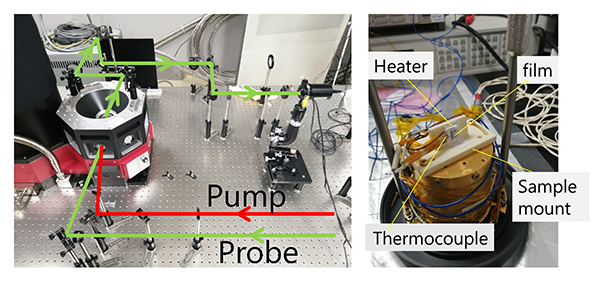TRMOKE system
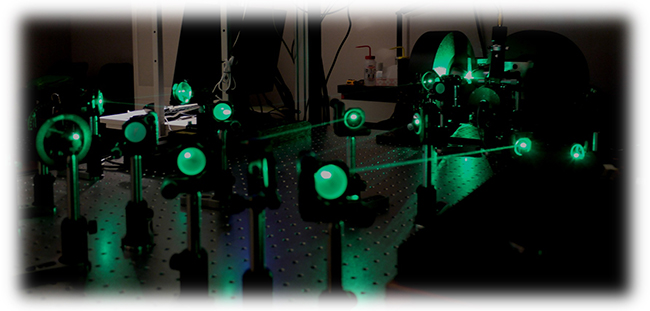
Femtosecond Laser
This is an ultra-short pulse laser created based on the technology that achieved the Nobel Prize in Physics in 2018 for its method of generating high-intensity ultra-short optical pulses. One femtosecond is one quadrillionth of a second. Even though light that can orbit the Earth seven and a half times in one second, it is only able to progress by 0.3 micrometers in such a fleeting moment. The femtosecond laser is characterized by its high intensity while minimizing the impact of heat, as it irradiates light within this brief moment. Therefore, it finds applications in laser processing technology and medical procedures. In the field of fundamental research, it is utilized to observe ultra-fast physical phenomena occurring in the femtosecond time domain.
Pump-probe method
This is a measurement technique for ultra-fast physical phenomena using a femtosecond laser. It employs two types of ultra-short optical pulses: a pump pulse to excite the physical phenomenon and a weak probe pulse for observation. Time-resolved measurements, akin to stroboscopic imaging, are performed by varying the time delay between the arrival of the pump and probe pulses at the sample. Connecting the signals corresponding to each moment in time reveals the time-resolved dynamics of the physical phenomenon.
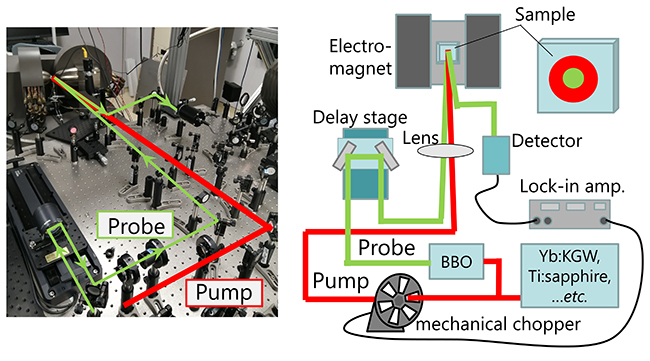
Ultrafast demagnetization
The femtosecond laser was developed in the mid-1960s, marking the beginning of exploring ultra-fast physical phenomena. In conventional metallic materials, the irradiation of ultra-short optical pulses excites electrons, and subsequently, energy dissipates into lattice vibrations during the relaxation process of the excited electrons. In contrast, in magnetic metallic materials, a phenomenon known as ultrafast demagnetization, where magnetization changes in less than 1 picosecond, was discovered in the late 1990s. It is considered that the spin arrangement in magnetic materials is put into disordered within sub-picoseconds during the relaxation process of the excited electrons. Leveraging phenomena such as ultrafast demagnetization in magnetic materials, various new technologies have been proposed, including high-efficiency terahertz wave generation and excitation of magnetization dynamics. [E. Beaurepaire, et al., Phys. Rev. Lett. 76, 4250 (1996).]
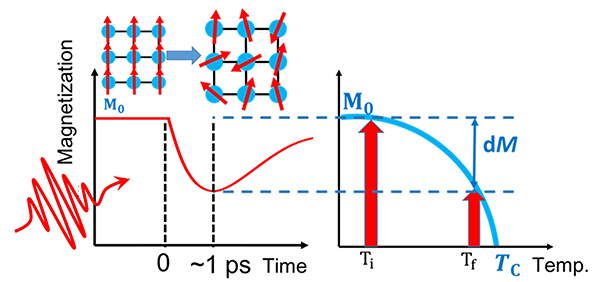
Time resolved magneto-optical Kerr effect (TRMOKE)
The magneto-optical Kerr effect is a phenomenon in which the polarization changes when light reflects on the surface of a magnetic material, depending on the magnetization state. By applying this, it is possible to observe the magnetization dynamics. In particular, time resolved magneto-optical Kerr effect (TRMOKE) is a measurement technique of the magnetization dynamics, excited by pump laser pulse, through the polarization change of the probe laser pulse. This allows us the observation of ultra-fast magnetization dynamics that cannot be observed with conventional measurement methods using only electrical devices. We can understand the magnetization dynamics in the magnetic materials with large magnetic anisotropy, such as permanent magnets and magnetic recording materials. [M. V. Kampen, et al., Phys. Rev. Lett. 88, 227201 (2002).]
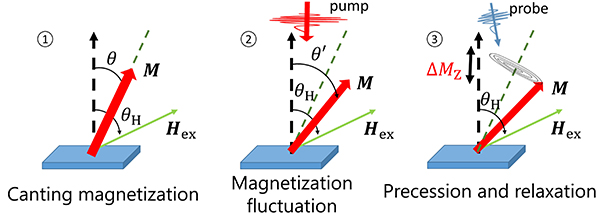
High temperature and high field TRMOKE system
Ferromagnetic materials with large magnetic anisotropy, which is important for practical applications, a large magnetic field of several T is required to investigate these magnetization dynamics. Superconducting magnet system is necessary to investigate the magnetization dynamics in those materials with large perpendicular magnetic anisotropy. Superconducting magnets are often utilized at low temperature in materials research. However, the operating conditions for practical applications are, usually, above room temperature. Our system realizes the experiments on ultra-fast magnetization dynamics up to around 400℃. This high temperature measurement allows us to understand the magnetization dynamics at actual working temperatures.
